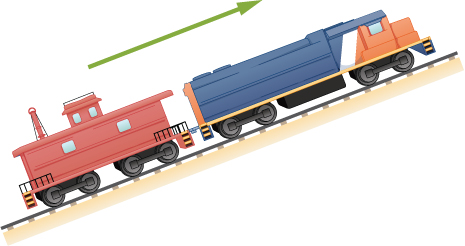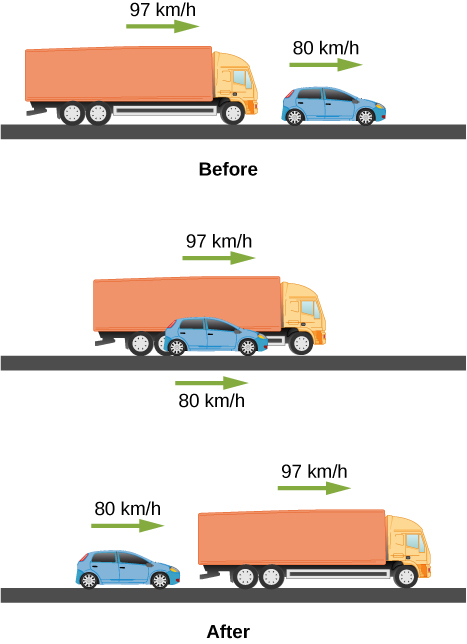| << Chapter < Page | Chapter >> Page > |
An object has an acceleration of . At , its velocity is . Determine the object’s velocities at and .
, ;
A particle moves along the x -axis according to the equation m. What are the velocity and acceleration at s and s?
A particle moving at constant acceleration has velocities of at s and at s. What is the acceleration of the particle?
A train is moving up a steep grade at constant velocity (see following figure) when its caboose breaks loose and starts rolling freely along the track. After 5.0 s, the caboose is 30 m behind the train. What is the acceleration of the caboose?

An electron is moving in a straight line with a velocity of m/s. It enters a region 5.0 cm long where it undergoes an acceleration of along the same straight line. (a) What is the electron’s velocity when it emerges from this region? b) How long does the electron take to cross the region?
a.
;
b.
An ambulance driver is rushing a patient to the hospital. While traveling at 72 km/h, she notices the traffic light at the upcoming intersections has turned amber. To reach the intersection before the light turns red, she must travel 50 m in 2.0 s. (a) What minimum acceleration must the ambulance have to reach the intersection before the light turns red? (b) What is the speed of the ambulance when it reaches the intersection?
A motorcycle that is slowing down uniformly covers 2.0 successive km in 80 s and 120 s, respectively. Calculate (a) the acceleration of the motorcycle and (b) its velocity at the beginning and end of the 2-km trip.
; solve simultaneously to get and , which is . Velocity at the end of the trip is .
A cyclist travels from point A to point B in 10 min. During the first 2.0 min of her trip, she maintains a uniform acceleration of . She then travels at constant velocity for the next 5.0 min. Next, she decelerates at a constant rate so that she comes to a rest at point B 3.0 min later. (a) Sketch the velocity-versus-time graph for the trip. (b) What is the acceleration during the last 3 min? (c) How far does the cyclist travel?
Two trains are moving at 30 m/s in opposite directions on the same track. The engineers see simultaneously that they are on a collision course and apply the brakes when they are 1000 m apart. Assuming both trains have the same acceleration, what must this acceleration be if the trains are to stop just short of colliding?
A 10.0-m-long truck moving with a constant velocity of 97.0 km/h passes a 3.0-m-long car moving with a constant velocity of 80.0 km/h. How much time elapses between the moment the front of the truck is even with the back of the car and the moment the back of the truck is even with the front of the car?

A police car waits in hiding slightly off the highway. A speeding car is spotted by the police car doing 40 m/s. At the instant the speeding car passes the police car, the police car accelerates from rest at 4 m/s 2 to catch the speeding car. How long does it take the police car to catch the speeding car?
Equation for the speeding car: This car has a constant velocity, which is the average velocity, and is not accelerating, so use the equation for displacement with : ; Equation for the police car: This car is accelerating, so use the equation for displacement with and , since the police car starts from rest: ; Now we have an equation of motion for each car with a common parameter, which can be eliminated to find the solution. In this case, we solve for . Step 1, eliminating : ; Step 2, solving for : . The speeding car has a constant velocity of 40 m/s, which is its average velocity. The acceleration of the police car is 4 m/s 2 . Evaluating t , the time for the police car to reach the speeding car, we have .

Notification Switch
Would you like to follow the 'University physics volume 1' conversation and receive update notifications?